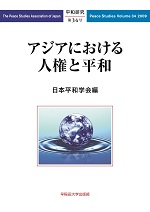34 巻
選択された号の論文の23件中1~23を表示しています
- |<
- <
- 1
- >
- >|
巻頭言
-
2009 年 34 巻 p. i-iv
発行日: 2009年
公開日: 2023/11/24
PDF形式でダウンロード (576K)
依頼論文
-
2009 年 34 巻 p. 1-20
発行日: 2009年
公開日: 2023/11/24
PDF形式でダウンロード (860K) -
2009 年 34 巻 p. 21-44
発行日: 2009年
公開日: 2023/11/24
PDF形式でダウンロード (921K) -
2009 年 34 巻 p. 45-65
発行日: 2009年
公開日: 2023/11/24
PDF形式でダウンロード (926K) -
2009 年 34 巻 p. 67-90
発行日: 2009年
公開日: 2023/11/24
PDF形式でダウンロード (1033K) -
2009 年 34 巻 p. 91-111
発行日: 2009年
公開日: 2023/11/24
PDF形式でダウンロード (1168K)
投稿論文
-
2009 年 34 巻 p. 113-134
発行日: 2009年
公開日: 2023/11/24
PDF形式でダウンロード (13098K) -
2009 年 34 巻 p. 135-151
発行日: 2009年
公開日: 2023/11/24
PDF形式でダウンロード (822K) -
2009 年 34 巻 p. 153-169
発行日: 2009年
公開日: 2023/11/24
PDF形式でダウンロード (873K) -
2009 年 34 巻 p. 171-187
発行日: 2009年
公開日: 2023/11/24
PDF形式でダウンロード (798K)
書評
-
2009 年 34 巻 p. 195-200
発行日: 2009年
公開日: 2023/11/24
PDF形式でダウンロード (645K) -
2009 年 34 巻 p. 201-204
発行日: 2009年
公開日: 2023/11/24
PDF形式でダウンロード (661K) -
2009 年 34 巻 p. 205-209
発行日: 2009年
公開日: 2023/11/24
PDF形式でダウンロード (630K)
SUMMARY
-
2009 年 34 巻 p. 217-218
発行日: 2009年
公開日: 2023/11/24
PDF形式でダウンロード (429K) -
2009 年 34 巻 p. 218-219
発行日: 2009年
公開日: 2023/11/24
PDF形式でダウンロード (451K) -
2009 年 34 巻 p. 219-220
発行日: 2009年
公開日: 2023/11/24
PDF形式でダウンロード (451K) -
2009 年 34 巻 p. 220-221
発行日: 2009年
公開日: 2023/11/24
PDF形式でダウンロード (428K) -
2009 年 34 巻 p. 221-222
発行日: 2009年
公開日: 2023/11/24
PDF形式でダウンロード (428K) -
2009 年 34 巻 p. 222-223
発行日: 2009年
公開日: 2023/11/24
PDF形式でダウンロード (428K) -
2009 年 34 巻 p. 223-224
発行日: 2009年
公開日: 2023/11/24
PDF形式でダウンロード (427K) -
2009 年 34 巻 p. 224-225
発行日: 2009年
公開日: 2023/11/24
PDF形式でダウンロード (450K) -
2009 年 34 巻 p. 225-226
発行日: 2009年
公開日: 2023/11/24
PDF形式でダウンロード (447K)
編集後記
-
2009 年 34 巻 p. 227-230
発行日: 2009年
公開日: 2023/11/24
PDF形式でダウンロード (581K)
- |<
- <
- 1
- >
- >|
